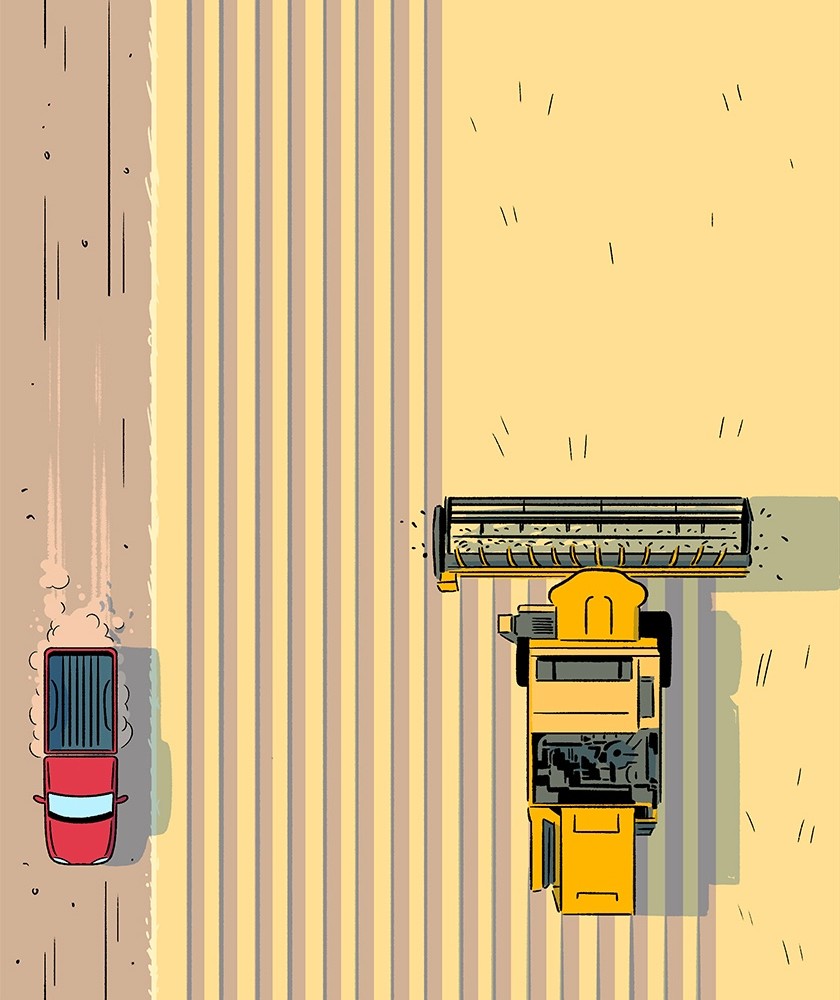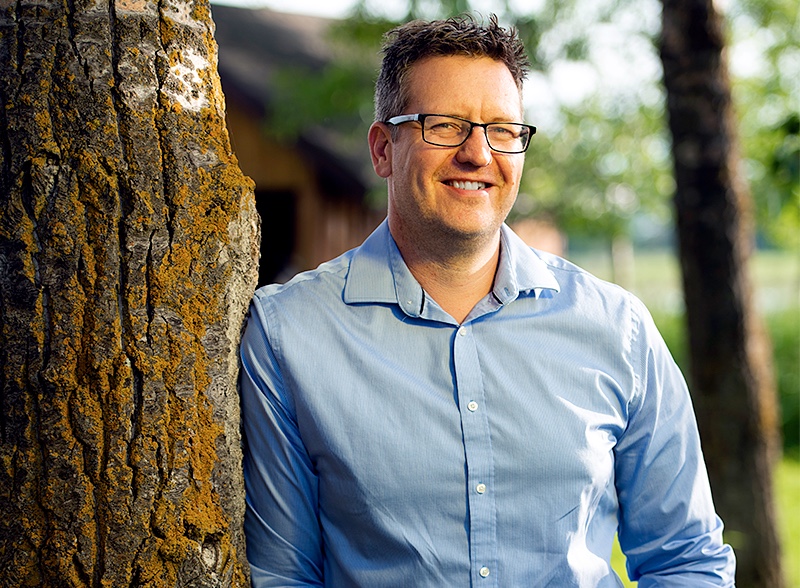Drive down southern Alberta’s Cowboy Trail, or Highway 22, and you won’t just see the cowboy-country landscape, like the Rockies in the distance, historic ranchland on either side, or the rolling foothills and woodlands. You’ll see rural mythmaking, too. A self-consciously rural esthetic reveals itself in neon silhouettes of pensive cowboys, ranch resorts, trading post landmarks and rodeo murals painted on the brick walls of pit stops. More than almost anywhere in North America, the cowboy style, which underpins rural mythology, is alive and kicking in Alberta. But the reality behind the myth is evolving, say U of A researchers.
“The nature of agriculture has really changed over the last three or four decades,” says Clark Banack, an adjunct professor at the University of Alberta and head of the Alberta Centre for Sustainable Rural Communities. A longtime rural Albertan, Clark is talking about farm communities along the Cowboy Trail, such as Longview and Cochrane.
“There’s been a real consolidation,” he explains. “The size of farms is growing exponentially, which means there are far fewer farm families living in rural areas. In addition, provincial government investment in rural communities has been in decline across Canada for decades.”
As Banack explains, since the Second World War, the industrialization of agriculture and the globalization of agri-food systems have marginalized small farmers and reshaped rural communities. But rural isn’t synonymous with agriculture: the number of rural workers employed in agriculture is declining in almost every OECD country. These broader trends of decline persist even in non-agricultural communities.
John Parkins, ’97 MSc, ’04 PhD, a professor in the Faculty of Agricultural, Life & Environmental Sciences, has researched rural development for more than 25 years, especially in forestry towns. “In forestry, it’s the same thing,” he says. “You can explain it with labour-shedding technologies and capital investments.”
Another factor is consolidation of ownership, Parkins says. “Being competitive requires a certain scale of operation, and that has implications for the number of owners and where the benefits flow. Historically, the fortunes of industry and community were closely connected. Now it’s the opposite. For the industry to maintain its competitive international position, to be efficient and produce for global markets, it needs to reduce costs. In contrast, communities need better livelihoods.”
The Alberta Centre for Sustainable Rural Communities is a joint initiative of the university’s Augustana Campus and the Faculty of Agricultural, Life & Environmental Sciences. While plenty of non-profits and universities study rural development, the centre is focused on fusing research with local outreach. The goal is to improve the sustainability of rural communities by connecting the U of A’s resources with rural organizations, researchers, students, policymakers and others who can create the needed changes. Rural resiliency, the thinking goes, depends on engaged, informed citizens, and the U of A holds a vast amount of knowledge that can be deployed outside its walls.
In the past few years, the centre has worked on projects related to inclusivity, park management, entrepreneurialism, food security and the health impacts of resource development.
One project underway is working to improve rural broadband in Alberta, a service that’s universally recognized as a precondition for rural resiliency but is still unavailable to many rural communities around the world. In Canada, only 54.3 per cent of rural residents have access to the minimum broadband speeds set by the Canadian Radio-television and Telecommunications Commission. The Alberta Centre for Sustainable Rural Communities has a tool called the Rural Broadband Portal, which compiles hundreds of resources related to the socio-economic impacts and economic opportunities of broadband. It curates the literature and makes policy suggestions so policymakers can easily access the kind of insights that otherwise would be arduous to collect.
The U of A is behind other broadband projects, too. The Alberta Rural Connectivity Coalition, founded by U of A digital technology experts Rob McMahon and Michael McNally, is a forum where communities share insights to help make informed decisions about broadband.
Another project underway at the rural sustainability centre looks at how rural co-operatives — a business model that democratizes ownership and decision-making — can improve economic development. That model has had success in rural Alberta, in the past and today. “In rural areas, co-operatives became popular 100 years ago because it was essentially ‘co-operate or don’t succeed,’ ” says Banack, who hosted a webinar in 2021 called “Old Solutions for New Problems: Why Alberta’s Small Towns Need to Consider Cooperatives.”
“They were an act of self-reliance. They had to co-operate to make ends meet, to acquire their farming goods at a reasonable price and to get a reasonable rate of return on the grains they grew.” The United Farmers of Alberta co-operative, for example, eventually formed government in the province and is still active today. Electricity and gas co-operatives have also played an important role in rural Alberta, and electrification programs carried out by co-operatives once provided about 90 per cent of Alberta farmers’ electricity. In Smoky Lake, Alta., parents spearheaded a co-operative daycare, and in Saskatchewan there are more than 100 preschool and daycare co-operatives.
Banack and Parkins both stress that rural decline has no easy solutions. Many rural communities weren’t built to last; they were service centres for economic organizations, specific industries, companies or settlement objectives that don’t exist anymore. Look no further than some of Alberta’s ghost towns: Coalspur, Coal Valley, Mercoal. Notice a theme? The challenge for many rural communities today is creating a future that moves beyond their origins — a stable future meant to last.
“Communities need a strategy if they want to define their own successful forms of rural development,” say Kristof Van Assche, a professor of planning, governance and development with the Faculty of Science. His research spans Europe and the Americas to Central Asia and Africa. He has written nearly a dozen books and countless publications.
“It requires tough self-analysis from those communities. What do they want? What do they have? What’s possible? They need a shared vision, then they can develop the policy tools and the autonomy to make bigger decisions. Often, there’s more creativity possible than people think.”
In a recent guide Van Assche co-wrote, Crafting Strategies for Sustainable Local Development: A Community Guide, he describes how there are no blueprints or silver bullets for moving small communities in new directions. A community is a complex system, and the infinite interactions between its components make the future less certain.
“Rather than predicting a future and organizing ourselves from there,” he writes, “it is possible and much more desirable to envision a future and from there a set of goals.”
Across the world, some of the most exciting success stories merge economic growth with conservation efforts. In Norway’s Morsa watershed, a collective of farmers and municipal governments demonstrates exemplary water governance. In Mexico, a community forestry enterprise called Palo Seco boasts outstanding environmental management, which helps create long-term local jobs while funding infrastructure.
This is where the rural ethos of rugged individualism can serve communities well: as a survival mechanism.
“The rural virtues of strong individualists can be productive,” Van Assche says. “If people feel like their family made this farmland and has been here for generations, or that they have worked together in this hamlet, it can be a strong safety net against the disintegration of rural areas.”
But he says rural communities may have to accept the need to form bigger units. “If many of these places are played against each other, if they’re just made to compete against each other for grants or for companies to settle there, that doesn’t help. Nobody can really survive by themselves.”
How do you quantify the soothing glint of first light on a foggy harvest morning? The euphony of birdsongs and tranquil whispers of wind? Sometimes it’s hard to articulate to outsiders why rural life is worth fighting for.
Roger Epp, ’84 BA(Hons), has a gift for making those ineffable qualities clear. A professor of political science at the U of A, Epp is a native of rural Saskatchewan and a former newspaperman, which may explain why he writes so stirringly about rural issues. Parkins, Van Assche and Banack all cite Epp as an influence. He co-edited Writing Off the Rural West, a tome of great significance in Canadian rural studies.
To Epp, the way we define rural — as abstract as it seems alongside cold, hard economics — is no trivial matter. In fact, he considers it essential to imagining rural futures, a vital part of what he calls “the long road from dependence to self-definition.”
One of the key elements to any viable rural future in the prairie West, he says, is an affirmation that rural is Indigenous space, too. As the Truth and Reconciliation Commission of Canada noted, the work of building a different way of living together is most real and most urgent in many rural places.
“The insistence that Indigenous communities are rural is a way of saying to rural communities, ‘Your closest allies, the people who live with the same distance and crappy internet that you do, and the people living next to extractive industries, are Indigenous. And you’re stronger with them than against them,’ ” Epp says.
The rancher and country artist I mentioned earlier, Corb Lund, re-recorded This is My Prairie in 2021 to support environmental activism in the Rockies. The new version features an ensemble of country stalwarts, as well as lesser-known artists such as Nice Horse, an all-female country group, Armond Duck Chief, who’s a member of the Siksika Nation, and Sherryl Sewepagaham, ’00 BEd, from the Little Red River Cree Nation in northern Alberta. Sewepagaham has a singular voice, and she sings in Cree. At one point, the other vocalists go mute and her words take centre stage. The titular “My” is transformed from the voice of a solitary rural landowner to that of a collective that foregrounds women and Indigenous Peoples.
It’s just a song, but it’s also a possible vision of the future, one that creates common ground to solve not only rural decline but also some of the globe’s great challenges.
“I’ll make my stand here, and I’ll die alone,” goes the song. That’s one possible future. Standing together is another.

























































































































































































































































































































































































































































We at New Trail welcome your comments. Robust debate and criticism are encouraged, provided it is respectful. We reserve the right to reject comments, images or links that attack ethnicity, nationality, religion, gender or sexual orientation; that include offensive language, threats, spam; are fraudulent or defamatory; infringe on copyright or trademarks; and that just generally aren’t very nice. Discussion is monitored and violation of these guidelines will result in comments being disabled.